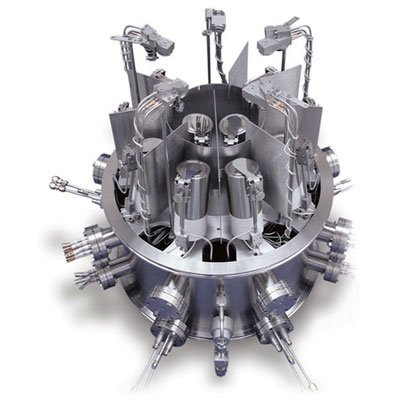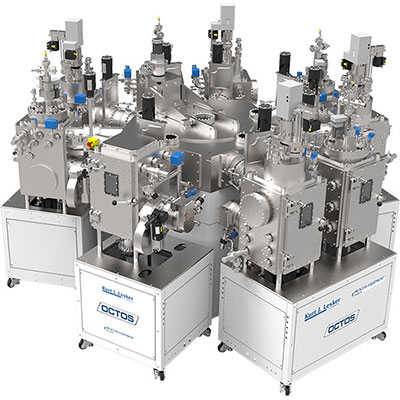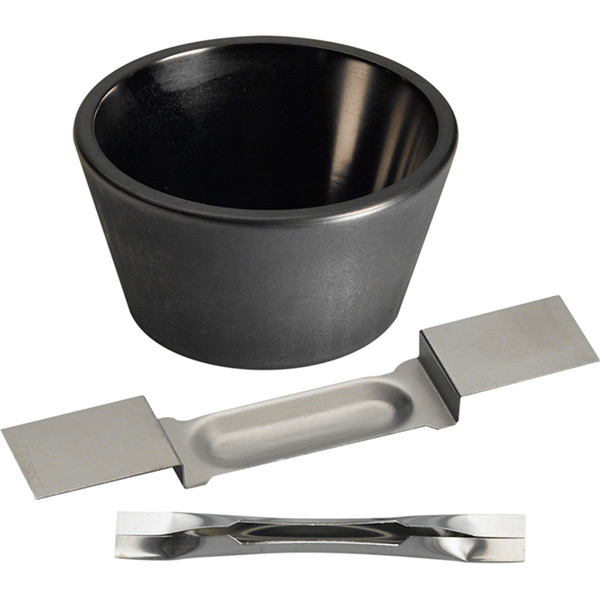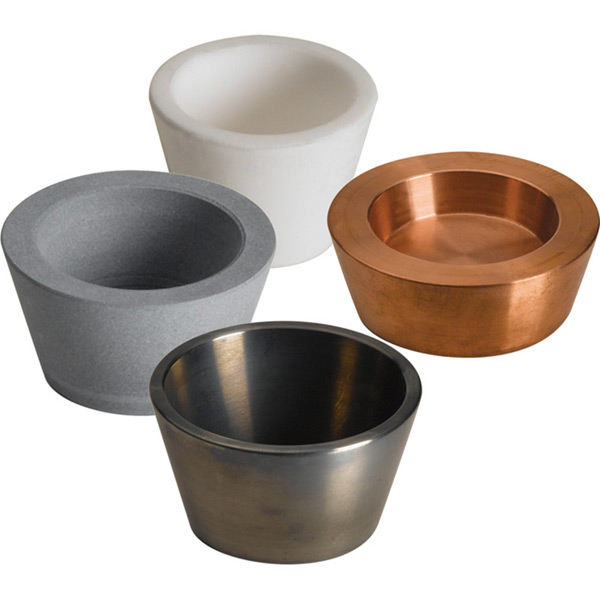Nickel/Iron (Ni/Fe 81/19 wt %) Pellets Evaporation Materials
Nickel/Iron (Ni/Fe 81/19 wt %) Pellets Overview
We sell these pellets and pieces by unit weight for evaporation use in deposition processes. These approximate materials prices are published to provide budgetary guidelines. Actual prices can vary and may be higher or lower, as determined by availability and market fluctuations. To speak to someone directly about current pricing, please click here .
Nickel/Iron (Ni/Fe 81/19 wt %) General Information
Nickel is a hard, lustrous, silvery-white metal. It has a density of 8.91 g/cc, a melting point of 1,453°C, and a vapor pressure of 10-4 Torr at 1,262°C. Iron is soft, gray, and metallic. It has a density of 7.86 g/cc, a melting point of 1,535°C, and a vapor pressure of 10-4 Torr at 1,180°C. The theoretical density of the nickel/iron 81/19 WT% alloy is 8.7 g/cc. Iron is very reactive with air, forming rust spots that flake off, exposing clean surfaces susceptible to oxidation. Nickel and iron are the most common elements in the earth's core and two of the most widely used metals in modern industry. Both elements are ferromagnetic, ductile, and conductors of heat and electricity. Naturally occurring nickel/iron alloys are often found in meteorites. Nickel/iron alloys are often evaporated in vacuum to form films in the production of semiconductors and magnetic storage media.
Empirical Determination of Z-Factor
Unfortunately, Z Factor and Shear Modulus are not readily available for many materials. In this case, the Z-Factor can also be determined empirically using the following method:
- Deposit material until Crystal Life is near 50%, or near the end of life, whichever is sooner.
- Place a new substrate adjacent to the used quartz sensor.
- Set QCM Density to the calibrated value; Tooling to 100%
- Zero thickness
- Deposit approximately 1000 to 5000 A of material on the substrate.
- Use a profilometer or interferometer to measure the actual substrate film thickness.
- Adjust the Z Factor of the instrument until the correct thickness reading is shown.
Another alternative is to change crystals frequently and ignore the error. The graph below shows the % Error in Rate/Thickness from using the wrong Z Factor. For a crystal with 90% life, the error is negligible for even large errors in the programmed versus actual Z Factor.
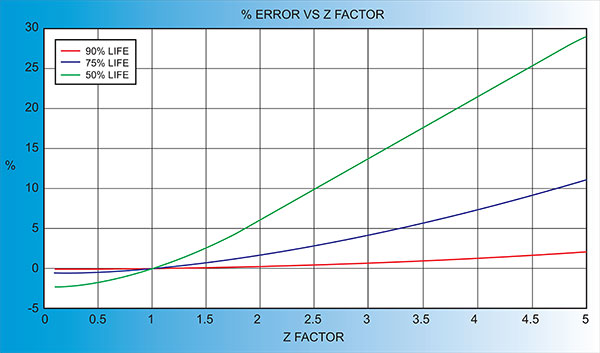
Thermal Evaporation of Nickel/Iron (Ni/Fe 81/19 wt %)
Nickel and iron each have a vapor pressure of ~1E-2 Torr at around 1,500°C with nickel's vapor pressure being slightly lower at any given temperature.
When the difference in atomic percentage is factored in, deposited films are expected to have a composition that is close to the 81/19 alloy. However, thermal evaporation is very difficult to accomplish with nickel/iron alloys. Both elements react with refractory metals when in liquid form, thus making evaporation out of a tungsten boat nearly impossible. Even when using a thin width, thick gauge tungsten boat such as our EVS20A015W, the alloy will vigorously attack the boat, causing it to crack and break. Therefore, the boat may not even last one run. Also, a tungsten boat may not work because there is risk that the materials may alloy with the tungsten, changing the mechanical and electrical properties of the boat. Due to differences between their melting points, the nickel and iron may briefly phase separate during evaporation. Because iron has a slightly higher vapor pressure at the same temperature as nickel, films may initially be iron rich.
An alternative option is to evaporate out of an aluminum oxide crucible. However, this method may also be unsuccessful. The crucible may only last for one run due to differences in the coefficients of expansion between the alloy and the aluminum oxide crucible as the melt cools. Because the material rests at the bottom of the crucible and, typically, the crucible's bottom is cooler than its sides, the heater and crucible must be heated to a much higher temperature to achieve evaporation. A power supply may not be capable of getting the heater hot enough. Also, at 1,500°C, the vapor pressure of the aluminum oxide and, possibly even the tungsten, may cause film contamination.
E-beam Evaporation of Nickel/Iron (Ni/Fe 81/19 wt %)
Electron beam evaporation is the preferred way to deposit nickel/iron alloys as both materials are rated "excellent" for this method. FABMATE® is the only crucible liner material recommended for the e-beam evaporation of nickel/iron. However, the crucible is limited to only one run. During evaporation, the nickel/iron will melt and adhere to the crucible liner walls. Upon cooling and reheating (if it makes it that far), the difference in thermal contraction and expansion of the nickel/iron and the FABMATE® liner will cause immense stress on the liner and it will crack.
A key process note is to consider the fill volume in the e-beam application because we find that the melt level of a material in the crucible directly affects the success of the crucible liner. Overfilling the crucible will cause the material to spill over and create an electrical short between the liner and the hearth. The outcome is cracking in the crucible. This is the most common cause of crucible liner failure. Placing too little material in the crucible or evaporating too much material before refilling can be detrimental to the process as well. When the melt level is below 30%, the e-beam is likely to strike the bottom or walls of the crucible which immediately results in breakage. Our recommendation is to fill the crucible between 2/3 and 3/4 full to prevent these difficulties. However, even when following these fill guidelines, the FABMATE® liner will still fail during cooling.
Crucible liners should be stored in a cool, dry place and always handled with gloves or forceps.
Nickel/iron can also be run directly from the copper hearth of the e-gun. Because of this, some customers prefer to use a pre-machined slug (or starter source) that is directly placed in the hearth pocket. The two main benefits of using a starter source are ease of use and handling as well as superior packing density. In order to avoid broken crucible liners, we have had customers install starter sources directly in the hearth.
Because not using a crucible liner is not always an option, especially in shared systems, some customers will use a copper crucible liner and place the starter source in the copper crucible liner instead of placing directly in the hearth.
KJLC® can produce these starter sources. Contact us by clicking here with your e-gun manufacturer, pocket size, and number of pockets in order for us to produce a quote.
See highlighted results that match your result in the table below.
Ordering Table
| Material | Description | Size | Quantity | Purity | Part Number | Price | In Stock | Add To Cart | |
|---|---|---|---|---|---|---|---|---|---|
| Material | Description | Size | Quantity | Purity | Part Number | Price | In Stock | Add To Cart | |
| Nickel/Iron |
NICKEL/IRON PELLETS, |
Nickel Iron (81/19 wt%) 1/8" Dia. x 1/8" Length |
100 g | 99.95% | EVMNIFEEXE-D | $183.00 |
|
||
| Nickel/Iron |
NICKEL/IRON PELLETS, |
Nickel Iron (81/19 wt%) 1/4" Dia. x 1/4" Length |
100 g | 99.95% | EVMNIFEQXQ-D | $167.00 |
|
||
| Nickel/Iron |
NICKEL/IRON PELLETS, |
Nickel Iron (81/19 wt%) 1/4" Dia. x 1/4" Length |
200 g | 99.95% | EVMNIFEQXQ-H | $217.00 |
|
||
| Nickel/Iron |
NICKEL/IRON PELLETS, |
Nickel Iron (81/19 wt%) 1/8" Dia. x 1/8" Length |
25 | 99.95% | EVMNIFEEXE-A | $124.00 |
|




